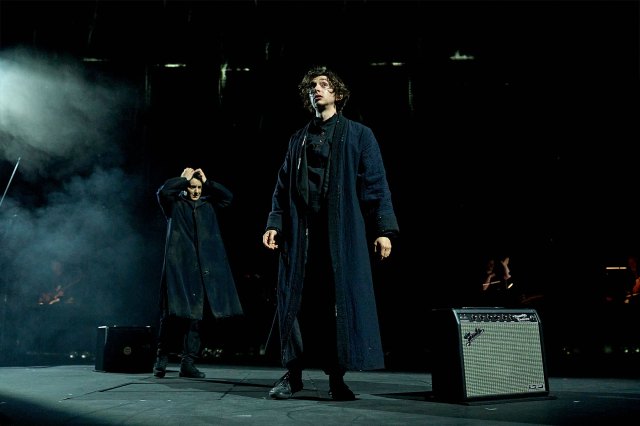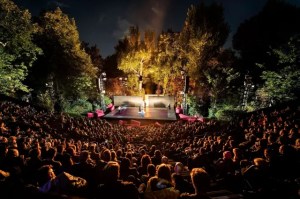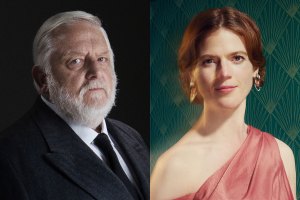Hamlet Hail to the Thief review – Radiohead rocks Shakespeare
The Royal Shakespeare Company and Factory International co-production features music by the award-winning band

The sense of foreboding and embarking on a perilous journey into paranoia starts on entry to the South Warehouse. There are winding, dimly lit passages to navigate around the towering steel structures that comprise the seating on three sides of the stage. Once seated the imposing stage looks like a huge bank of speakers ready for a stadium gig while also effectively portraying the imposing royal home at Elsinore. Banks of icy fog immerse the stage, swathing around a series of black suits suspended in the air like the remnants of ghostly figures already haunting this eerie place. The slow build of tension is amplified by the fractured sound of Radiohead 2003 seminal album Hail To The Thief, newly orchestrated by Thom Yorke for this experimental production with long term collaborators Christine Jones and Steven Hoggett.
There are a lot of professional reputations at stake in this highly anticipated piece that opens here at Factory International before moving to the Royal Shakespeare Theatrre. Shakespeare might well be rolling in his grave to see his Hamlet trimmed down to a one hour 45 minutes, with elements of the story told swiftly and deftly through movement sequences to a backdrop of an album by an eclectic post punk band.
No one need fear, however: the final result is a resounding success that delivers something quite special. The parallels in the themes running through the album and the play are those of making complex human decisions and navigating consequences, alongside the paranoia and distrust that comes with trust fractured by family or by state. Here they all collide, shear through each other like shards of glass, or unite as in a dance of wild abandon.

One of the most potent elements of this production is the way in which Ophelia is portrayed. Here she is no passive waif-like creature floating down a river in her nightgown. Ami Tredrea is wonderfully vibrant and insouciant – beginning confident and happy. Like Hamlet, her ultimate tragedy is not being weighed down by the water but by the psychological weight of too many tragedies colliding in quick succession. The scene where they dance together is rendered perfectly. Choreographed to suggest a young Uma Thurman and John Travolta in Pulp Fiction, they are playful and exuberant in their mutual attraction. In that moment, it’s painstakingly clear to see who this young couple could have been, if they were not destined to be another pair of star-crossed young lovers in a Shakespearean tragedy.
Samuel Blenkin as Hamlet is full of youthful vigour and searing, sardonic wit. His hollow-cheeked youth is utterly believable as a young man who simply cannot make sense of the seismic changes in his world. Teetering between grief for his loss, revulsion at the actions of his mother and unbridled love for Ophelia, it is no surprise that this prince is rendered frozen with indecision.
The staging by AMP and Sadra Tehrani is strikingly evocative and houses the live band in a way that cleverly echoes the Liam Gillick art installation used in a 2017 New Order performance for Manchester International Festival. This weaving of the musicians into the set as inhabitants of Elsinore further connects the albums’ political themes into the narrative as they watch the dirty politics play out on stage. The choreography by Jess Williams has all the impact of a Frantic Assembly piece as performers fluidly drive the narrative. Lurching and teetering, they echo Hamlet’s indecision or grapple like stags for male supremacy. The funeral scene becomes a masterclass in competitive grieving as Hamlet and Laertes face off. The final fight scene is brutally visceral but every movement in the chaos of death is telling multiple colliding stories in a powerful and poignant manner.
Powered by an idea by Jones after seeing tracks from Hail To The Thief performed in 2003 and subsequently working on a production of Hamlet, this collaboration has been a long-standing melting pot of ideas with Yorke and Hoggett. It make have taken these creatives a lot longer to formulate a plan “to be, or not to be” and bring it to the stage than it takes Hamlet to finally act on his fevered imaginings, but this final outcome is certainly worth the wait.
















